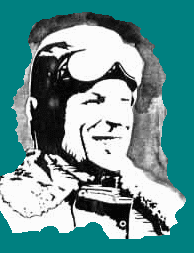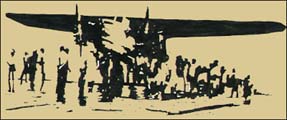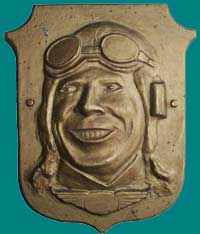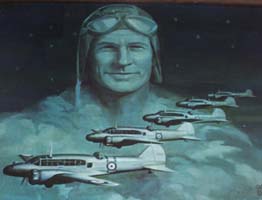© Jim Low
 On the morning of May 31, 1928, the three-engined Southern Cross began the first successful flight across the Pacific Ocean from Oakland airport, San Francisco, on the west coast of the United States of America, to Australia. On board were two Australian pilots, Charles Kingsford-Smith and Charles Ulm, as well as two Americans, the radio operator James Warner and the navigator Harry Lyon.
On the morning of May 31, 1928, the three-engined Southern Cross began the first successful flight across the Pacific Ocean from Oakland airport, San Francisco, on the west coast of the United States of America, to Australia. On board were two Australian pilots, Charles Kingsford-Smith and Charles Ulm, as well as two Americans, the radio operator James Warner and the navigator Harry Lyon.
A year before, Kingsford-Smith and Ulm had been successful in flying around Australia in a record time of ten days. The flight across the Pacific was to be a real test for the four-man crew. The constant roar of the three engines made sleeping very difficult and caused continual vibration. The noise also meant that the two pilots could only communicate with Warner and Lyon, both in the navigation cabin behind them, by writing notes. The weather conditions, which included storms and heavy rain, made writing at times difficult. Their fingers became numb when the aeroplane was forced to increase altitude. Conditions on board were cramped and the part-open cockpit did not protect the pilots from a drenching when it rained. Lacking the pressurised cabins of today meant that they could not attempt to escape storms or turbulence by flying above such bad weather conditions.
They worried constantly about the amount of petrol they used. There were long periods of flying ‘blind’, relying only on their navigational instruments and guesswork to fly through the night.
After stops in Honolulu and Suva, the Southern Cross finally reached Brisbane on the morning of June 9, completing a journey of just under 12 000 kilometres across the Pacific Ocean.
A short time before his death in 1976, my father gave me his copy of “The Story of the Southern Cross” by Kingsford-Smith and Ulm. The book gives a graphic account of their fight across the Pacific Ocean. On the front piece of the book, in my father’s writing, are the words “What a story”. Apparently my father wrote this when he first read the book. He also pasted newspaper cuttings about the Pacific flight on the front and back piece.
My father often spoke to me about Smithy, as Kingsford-Smith was often affectionately named. I remember him telling me about the night the Southern Cross became lost on the return flight over the Tasman Sea in October, 1928. Ulm and Smithy were flying from New Zealand to Richmond, on the outskirts of Sydney. They encountered strong headwinds on the homeward fight, which took nearly twenty-three hours. (The Richmond to Christchurch leg of the crossing had taken them almost fourteen and a half hours.)
My father was attending an evening picture show at the Royal Theatre in Willoughby, on Sydney’s lower north shore. He remembered the film being interrupted to inform the audience about the airmen’s plight.
After the pictures, my father went home and, on his crystal set, was able to pick up the radio signals from the Richmond aeroplane base, where the Southern Crosswas expected to land. My father attached his “Star” aerial to the family clothesline to obtain a better reception. At one stage while flying down the coast, the Southern Cross flew low over my father’s suburb. Being such a very dark night, the airmen had decided to use the lights from the railway line on Sydney’s northern shore to guide them until they found their bearings.
On hearing the noise coming from the ‘plane’s twenty-seven cylinders, my father rushed out side in his pyjamas. From the road he looked up and saw the flames roaring from the engines just above his head.
“Believe me,” he recalled, “it was the thrill of my life when that giant ‘plane went over my head by only a few yards, with twenty-seven cylinders barking and flames flowing out from their twenty-seven exhaust pipes!”
When the Southern Cross finally touched down at Richmond, Kingsford-Smith announced that there was only enough petrol for another half-hour of flying. “So ended a great flight,” my father summed up his recollections.
Another time my father mentioned how he saw a calendar that featured a painting of Smithy’s head, above clouds and five aeropanes flying in formation. Wanting a copy for himself, with perseverance, he eventually tracked one down. He also made a plaster cast of Smithy’s head in his aviation attire and painted it gold. For as long as I can remember it hung on the wall in our family home, along with the framed calendar painting. I now have them both hanging on the wall of my study.
A few weeks after his death, I read Smithy and Ulm’s book which had been such a favourite of my father. Like him, I was impressed by the story. Not long after this I wrote the song From Oakland to Brisbane about the Pacific crossing.
In 1978 the late Reverend Ted Noffs, of the Wayside Chapel in Sydney’s Kings Cross, planned to commemorate the 50th anniversary of the Pacific flight by unveiling a plaque in memory of Kingsford-Smith. This was to be the first in a series of plaques to honour great Australians in the Chapel’s “Heritage Way”. Hearing that I had written a song about the flight, Ted invited me to sing it at the unveiling ceremony. Charles Kingsford-Smith Jr, who had just retraced his father’s trans-Pacific flight, unveiled the plaque. Later I had the opportunity to talk with him. I showed him my father’s book, which he was kind enough to sign. He was really taken by my father’s written comment about the book and all the related newspaper cuttings he had gathered.
I reckon my father would have been very pleased with this happy turn of events. I also felt that if I never sang my song again, it had achieved more than I could ever have imagined.
© Jim Low



